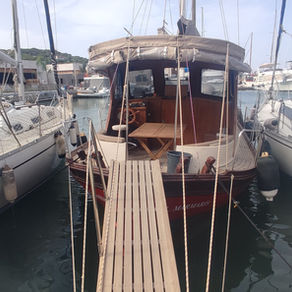The Importance of Antifouling Paint Application During Pre-Season Boat Preparations
- marmaristms

- Apr 15
- 2 min read

One of the most critical steps in preparing boats for the season is applying antifouling paint to the hull's underwater surface. This coating plays a vital role in both performance and hull protection by preventing marine organisms (biofouling) from attaching to the boat's surface.
Function and Mechanism of Antifouling Paint
Antifouling paints are specialized coatings containing biocides (typically copper-based compounds and organic substances). These biocides are gradually released into the water, preventing microorganisms, algae, barnacles, and other marine life from adhering to the boat's surface. The effectiveness of the paint depends on the type, concentration, and dissolution rate of the biocides used.
Types of Antifouling Paint and Selection Criteria
Ablative Paints: These paints wear away gradually when exposed to water, continuously exposing a fresh layer of biocides. They provide long-term protection and are ideal for high-speed vessels.
Self-Polishing Paints: These paints dissolve in a controlled manner, offering more stable protection. They are suitable for boats with low to moderate speeds.
Hard Paints: These do not wear away but release biocides slowly. They are used for vessels that operate at low speeds.
The choice of paint depends on factors such as the boat's usage, cruising speed, water type, and climate conditions.
Impact on Performance
Biofouling increases water resistance and drag on the hull, which can:
Increase fuel consumption by 10-30%.
Reduce maximum speed.
Accelerate mechanical wear on engines and propellers by increasing their workload.
Proper and regular application of antifouling paint minimizes these negative effects, enhancing fuel efficiency and optimizing sailing performance.
Hull Protection and Material Durability
Marine organisms adhering to the hull can cause corrosion and structural damage, particularly in wooden, composite, or aluminium boats. Antifouling paint prevents this by:
Reducing the risk of electrochemical corrosion.
Preventing mechanical wear on the hull surface.
Lowering long-term maintenance and repair costs.
Application Process and Key Considerations
Surface Preparation: The hull must be clean, dry, and smooth before application. Old paint residues and dirt should be sanded off, and a primer may be applied if necessary.
Number of Coats: Typically, 2-3 coats are applied as per manufacturer recommendations, allowing sufficient drying time between layers.
Environmental Conditions: Factors such as temperature, humidity, and wind during application affect paint quality. Optimal conditions should be ensured.
Safety Measures: Proper protective equipment should be used during application, and waste materials must be managed responsibly to avoid environmental harm.
Environmental Impact and Current Trends
Traditional copper-based antifouling paints can harm marine ecosystems, leading to restrictions in some regions. As a result, more eco-friendly alternatives with lower toxicity levels are being developed. When selecting antifouling paint, regional regulations and environmental considerations should be taken into account.
Conclusion
Antifouling paint application is essential for maintaining your boat's performance, saving fuel costs, and extending the hull lifespan. Choosing the right paint based on technical specifications and usage conditions, combined with professional application, ensures a safe and economical boating season.









Comments